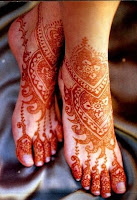Art of Mehandi - An Introduction
The art of mehndi (or mehandi) has been a long-standing tradition stemming from many ancient cultures dating back as far as about 5,000 years, but is most known today for its history in India. Today, it is still used in religious and ritualistic ceremonies in India, but has also gained appreciation in other countries as a beautiful art to be appreciated at any time.
So, what exactly is mehndi?
Mehndi is a temporary art done on the body with henna. Henna powder is derived from a plant (actually a bush), Lawsonia inermis, commonly found in the Middle East and other areas where the climate is hot and dry. The bush is harvested, dried, and then crushed to make henna powder. Henna itself is used for many things such as hair treatment, heat rash relief, and skin conditioner to name a few. The top leaves of the plant are best for mehndi, while the lower part of the plant is used for the other purposes. Henna paste is what is made to apply henna art designs.
Henna powder itself is green in color, but the stain it leaves behind is usually an orange-red color. There are many suppliers now that offer henna in a variety of colors but these are not recommended. Pure henna has had little to no incident of allergic reaction. When colors are added to natural henna, reactions can be mild to severe. Black henna especially has been known to cause serious skin burns as a result of the chemicals added to it to produce the black color effect. Henna is best to be appreciated in its purest form.
Most who are familiar with henna have seen the traditional designs. These beautifully intricate patterns are similar to those used for the marriage ceremonies and other rituals. They usually adorn the hands and feet of the wearer, and require that they remain still for many hours to apply the paste and then allow it to dry. Henna color has been known to take best to the hands and feet due to their dry properties which soak up and hold the color better, but henna can be applied anywhere. How well your skin takes to the henna will depend on each individual's skin properties.
Today, henna has been done in many forms including more contemporary designs. Some contemplating a permanent tattoo might apply henna first to see if they like the look before making a permanent decision. Some just enjoy having a temporary design they know will wash off in a few weeks. Whatever your reasons might be for being interested in henna, you are delving into a beautiful form of art rich in culture.
Subscribe to:
Post Comments (Atom)
Powered by Blogger.


3 comments:
Thank you for the email Priyadharshini.
Manoharan,
Ma's Kitchen - Catering Services Chennai, Wedding Planners
http://www.maskitchen.in
Nice. Thanx for sharing..
Keep rocking..
Your blog is wonderful. Thanks for following my blog.
Post a Comment